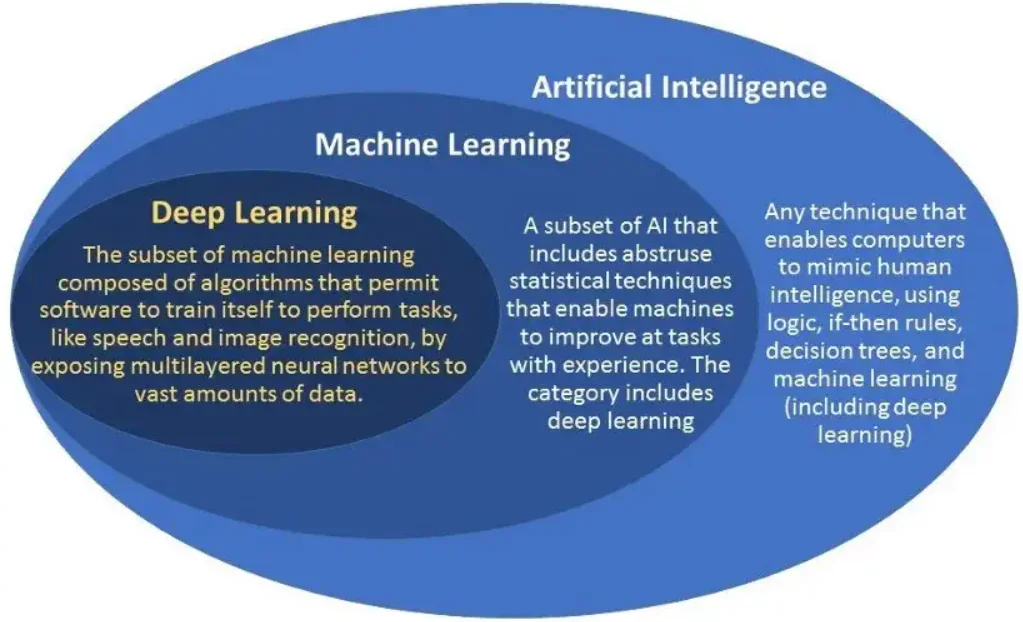Artificial Intelligence
Machine learning vs. Deep learning – Key Differences

Terminologies like Artificial Intelligence (AI), Machine Learning (ML), and Deep Learning are hype these days. People, however, often use these terms interchangeably. Although these terms highly co-relate with each other, they also have distinctive features and specific use cases.
AI deals with automated machines that solve problems and make decisions imitating human cognitive capabilities. Machine learning and deep learning are the subdomains of AI. Machine Learning is an AI that can make predictions with minimal human intervention. Whereas deep learning is the subset of machine learning that uses neural networks to make decisions by mimicking the neural and cognitive processes of the human mind.
The above image illustrates the hierarchy. We will continue with explaining the differences between machine learning and deep learning. It will also help you choose the suitable methodology based on its application and area of focus. Let’s discuss this in detail.
Machine Learning in a Nutshell
Machine learning allows experts to “train” a machine by making it analyze massive datasets. The more data the machine analyzes, the more accurate results it can produce by making decisions and predictions for unseen events or scenarios.
Machine learning models need structured data to make accurate predictions and decisions. If the data is not labeled and organized, machine learning models fail to comprehend it accurately, and it becomes a domain of deep learning.
The availability of gigantic data volumes in organizations has made machine learning an integral component of decision-making. Recommendation engines are the perfect example of machine learning models. OTT services like Netflix learn your content preferences and suggest similar content based on your search habits and watch history.
To understand how machine learning models are trained, let's first look at types of ML.
There are four types of methodologies in machine learning.
- Supervised learning – It needs labeled data to give accurate results. It often requires learning more data and periodic adjustments to improve outcomes.
- Semi-supervised – It’s a middle tier between supervised & unsupervised learning that exhibits the functionality of both domains. It can give results on partially labeled data and doesn't require ongoing adjustments to give accurate results.
- Unsupervised learning – It discovers patterns and insights in datasets without human intervention and gives accurate results. Clustering is the most common application of unsupervised learning.
- Reinforcement learning – The reinforcement learning model requires constant feedback or reinforcement as new information comes to give accurate results. It also uses a “Reward Function” that enables self-learning by rewarding desired outcomes and penalizing wrong ones.
Deep Learning in a Nutshell
Machine learning models need human intervention to improve accuracy. On the contrary, deep learning models improve themselves after each result without human supervision. But it often requires more detailed and lengthy volumes of data.
The deep learning methodology designs a sophisticated learning model based on neural networks inspired by the human mind. These models have multiple layers of algorithms called neurons. They continue to improve without human intervention, like the cognitive mind that keeps improving and evolving with practice, revisits, and time.
Deep learning models are mainly used for classification and feature extraction. For instance, deep models feed on a dataset in facial recognition. The model creates multidimensional matrices to memorize each facial feature as pixels. When you ask it to recognize a picture of a person it was not exposed to, it easily recognizes it by matching limited facial features.
- Convolutional Neural Networks (CNN) – Convolution is the process of assigning weights to different objects of an image. Based on these assigned weights, the CNN model recognizes it. The results are based on how close these weights are to the object's weight fed as a train set.
- Recurrent Neural Network (RNN) – Unlike CNN, the RNN model revisits the previous results and data points to make more accurate decisions and predictions. It’s an actual replica of human cognitive functionality.
- Generative Adversarial Networks (GANs) – The two classifiers in GAN, the generator & discriminator, access the same data. The generator produces fake data by incorporating feedback from the discriminator. The discriminator tries to classify whether a given data is real or fake.
Salient Differences
Below are some notable differences.
| Differences | Machine Learning | Deep Learning |
| Human Supervision | Machine learning requires more supervision. | Deep learning models require almost no human supervision after development. |
| Hardware Resources | You build and run Machine learning programs on a powerful CPU. | Deep learning models require more powerful hardware, like dedicated GPUs. |
| Time & Effort | The time required to set up a Machine learning model is less than deep learning, but its functionality is limited. | It requires more time to develop and train data with deep learning. Once created, it continues to improve its accuracy with time. |
| Data (structured/unstructured) | Machine learning models need structured data to give results (except unsupervised learning) and require continuous human intervention for improvement. | Deep learning models can process unstructured and complex datasets without compromising accuracy. |
| Use-cases | eCommerce websites and streaming services that use recommendation engines. | High-end applications like Autopilot in planes, self-driving vehicles, Rovers on the Martian surface, face recognition, etc. |
Machine Learning vs. Deep Learning – Which one is best?
The choice between machine learning vs. deep learning is genuinely based on their use cases. Both are used to make machines with near-human intelligence. The accuracy of both models depends on whether you are using the relevant KPIs and data attributes.
Machine learning and deep learning will become routine business components across industries. Undoubtedly, AI will fully automate industries activities like aviation, warfare, and cars in the near future.
If you want to know more about AI and how it continuously revolutionizes business outcomes, read more articles on unite.ai.














